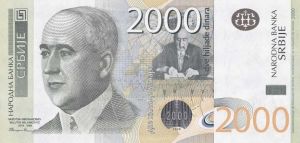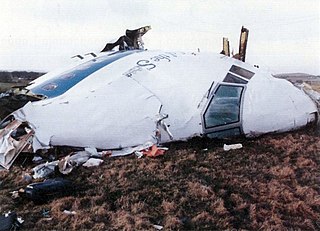This article relies largely or entirely on a single source .(November 2024) |
| |||||
| Decades: | |||||
|---|---|---|---|---|---|
| See also: | Other events of 1986 List of years in Libya | ||||
The following lists events that happened during 1986 in Libya .
This article relies largely or entirely on a single source .(November 2024) |
| |||||
| Decades: | |||||
|---|---|---|---|---|---|
| See also: | Other events of 1986 List of years in Libya | ||||
The following lists events that happened during 1986 in Libya .

The United States Air Force, Navy, and Marine Corps carried out air strikes, code-named Operation El Dorado Canyon, against Libya on 15 April 1986 in retaliation for the West Berlin discotheque bombing ten days earlier, which U.S. President Ronald Reagan blamed on Libyan leader Muammar Gaddafi. There were 40 reported Libyan casualties; one U.S. plane was shot down. One of the claimed Libyan deaths was of a baby girl, reported to be Gaddafi's daughter, Hana Gaddafi. However, there are doubts both as to whether she was really killed, or whether she truly existed.

Muammar Muhammad Abu Minyar al-Gaddafi was a Libyan revolutionary, politician and political theorist who ruled Libya from 1969 until his assassination by rebel forces in 2011. He came to power through a military coup, first becoming Revolutionary Chairman of the Libyan Arab Republic from 1969 to 1977 and then the 'Brotherly Leader' of the Great Socialist People's Libyan Arab Jamahiriya from 1977 to 2011. Initially ideologically committed to Arab nationalism and Nasserism, Gaddafi later ruled according to his own Third International Theory.

The Kuwaiti dinar is the currency of Kuwait. It is sub-divided into 1,000 fulūs.

The Iraqi dinar is the currency of Iraq. The Iraqi dinar is issued by the Central Bank of Iraq (CBI). On 7 February 2023, the exchange rate with the US Dollar was US$1 = 1300 dinars.

The dinar is the official currency of Libya. The dinar is divided into 1,000 dirhams (درهم). It is issued by the Central Bank of Libya, which also supervises the banking system and regulates credit.

The dinar is the currency of Serbia. The dinar was first used in Serbia in medieval times, its earliest use dating back to 1214. The dinar was reintroduced as the official Serbian currency by Prince Mihailo in the 1868. One dinar was formerly subdivided into 100 para. As of 24 August 2024, 1 US dollar worth 104.57 dinars.

The dirham, dirhem or drahm is a unit of currency and of mass. It is the name of the currencies of Morocco, the United Arab Emirates and Armenia, and is the name of a currency subdivision in Jordan, Libya, Qatar and Tajikistan. It was historically a silver coin.
The dinar is the monetary currency of Algeria and it is subdivided into 100 centimes. Centimes are now obsolete due to their extremely low value.

The dinar is the currency of Bahrain. It is divided into 1000 fils. The Bahraini dinar is abbreviated د.ب (Arabic) or BD (Latin). It is usually represented with three decimal places denoting the fils.

The dinar is the national currency of Tunisia. It is subdivided into 1000 milim or millimes (ملّيم). The abbreviation DT is often used in Tunisia, although writing "dinar" after the amount is also acceptable ; the abbreviation TD is also mentioned in a few places, but is less frequently used, given the common use of the French language in Tunisia, and the French derivation of DT.

The Palestine pound was the currency of the British Mandate of Palestine from 1 November 1927 to 14 May 1948, and of the State of Israel between 15 May 1948 and 23 June 1952, when it was replaced with the Israeli pound.

Muammar Gaddafi became the de facto leader of Libya on 1 September 1969 after leading a group of young Libyan Army officers against King Idris I in a bloodless coup d'état. When Idris was in Turkey for medical treatment, the Revolutionary Command Council (RCC) headed by Gaddafi abolished the monarchy and the old constitution and established the Libyan Arab Republic, with the motto "freedom, socialism and unity". The name of Libya was changed several times during Gaddafi's tenure as leader. From 1969 to 1977, the name was the Libyan Arab Republic. In 1977, the name was changed to Socialist People's Libyan Arab Jamahiriya. Jamahiriya was a term coined by Gaddafi, usually translated as "state of the masses". The country was renamed again in 1986 as the Great Socialist People's Libyan Arab Jamahiriya, after the United States bombing that year.

Pan Am Flight 103 (PA103/PAA103) was a regularly scheduled Pan Am transatlantic flight from Frankfurt to Detroit via a stopover in London and another in New York City. The transatlantic leg of the route was operated by Clipper Maid of the Seas, a Boeing 747 registered N739PA. Shortly after 19:00 on 21 December 1988, while the aircraft was in flight over the Scottish town of Lockerbie, it was destroyed by a bomb, killing all 243 passengers and 16 crew in what became known as the Lockerbie bombing. Large sections of the aircraft crashed in a residential street in Lockerbie, killing 11 residents. With a total of 270 fatalities, it is the deadliest terrorist attack in the history of the United Kingdom.

Libya–United States relations are the bilateral relations between the State of Libya and the United States of America. Relations are today cordial and cooperative, with particularly strong security cooperation only after the 2012 attack on the US liaison office or mission in Benghazi. Furthermore, a Gallup poll conducted in March and April 2012 found that Libyans had "among the highest approval" of US leadership in the entire Middle East and North Africa region.

The United States dollar is the official currency of the United States and several other countries. The Coinage Act of 1792 introduced the U.S. dollar at par with the Spanish silver dollar, divided it into 100 cents, and authorized the minting of coins denominated in dollars and cents. U.S. banknotes are issued in the form of Federal Reserve Notes, popularly called greenbacks due to their predominantly green color.
British involvement in the Middle East began with the General Maritime Treaty of 1820. This established the Trucial States and the nearby island of Bahrain as a base for suppressing sea piracy in the Persian Gulf. Meanwhile, in 1839 the British East India Company established an anti-piracy station in Aden to protect British shipping that was sailing to and from India. Involvement in the region expanded to Egypt in 1875 because of British interests in the Suez Canal, with a full scale British invasion of Egypt taking place in 1882. Muscat and Oman became a British Protectorate in 1891, and meanwhile Kuwait was added to the British Empire in 1899 because of fears surrounding the proposed Berlin-Baghdad Railway. There was a growing concern in the United Kingdom that Germany was a rising power, and about the implications that the proposed railway would have as regards access to the Persian Gulf. Qatar became a British Protectorate in 1916, and after the First World War, the British influence in the Middle East reached its fullest extent with the inclusion of Palestine, Transjordan and Iraq.

Libya–Yugoslavia relations were historical foreign relations between Libya and now split-up Socialist Federal Republic of Yugoslavia. Two countries established formal diplomatic relations in 1955.